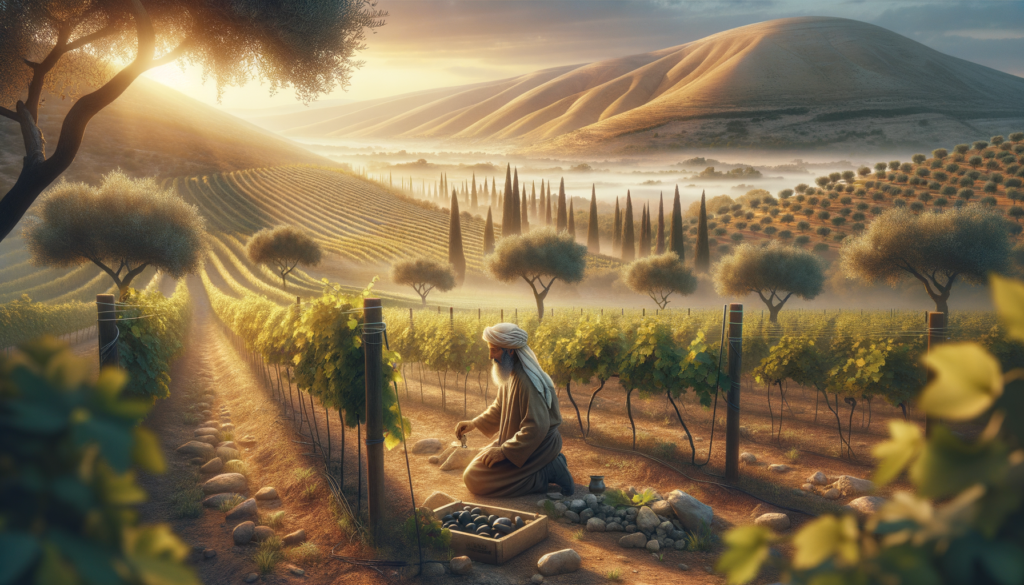The Winding Vine: A Beautiful Symbol of Israel and Its People

In the rolling hills and sun-kissed valleys of ancient Israel, few sights were as cherished as a flourishing vineyard. The grapevine, with its winding branches and heavy clusters of fruit, was more than just a source of food and drink; it was a plant deeply woven into the spiritual and national identity of the people. Throughout the pages of the Hebrew Bible, the vine appears as a powerful and recurring symbol, representing the nation of Israel itself, the blessings of peace and prosperity, and the simple, profound joy of a life rooted in the land. Join us as we explore the beautiful and layered symbolism of this remarkable plant.
The Vine as a Symbol of the Nation of Israel
Perhaps the most important symbolic meaning of the grapevine in the Tanakh is its representation of the people of Israel. The prophets, particularly Isaiah, Jeremiah, Hosea, and Ezekiel, often used the metaphor of a vineyard to describe the nation. In this imagery, the land is a carefully tended vineyard, and the people are the vines planted within it. This metaphor speaks to a relationship of care and expectation, a sense that the people, like vines, were chosen and cultivated to produce good fruit—righteousness, justice, and faithfulness. When the nation strayed, the prophets would speak of a neglected vineyard or a vine producing sour grapes, a poignant image of a people not living up to their potential.
Isaiah, for example, describes a song of the beloved vineyard (Isaiah 5), where the owner did everything possible to care for the vines—clearing stones, planting choice vines, building a watchtower—yet the vineyard yielded only wild grapes. This story is not just agricultural imagery, but a mirror held up to the nation, calling it back to justice and integrity. Jeremiah echoes this theme, lamenting that a noble vine had turned into a strange, degenerate plant (Jeremiah 2:21). Hosea, too, speaks of Israel as a flourishing vine, which once bore fruit in abundance but later became entangled in false directions. These prophetic voices use the image of the vine to stir the heart, reminding the people of their higher calling and their rootedness in the land.
A Symbol of Prosperity and the Goodness of the Land
The vine was also a direct and tangible symbol of the abundance and blessing of the Land of Israel. The most famous example is in the Book of Numbers, when the twelve spies are sent to scout the promised land. They return carrying a cluster of grapes so large and heavy that it requires two men to carry it on a pole. This overflowing cluster of fruit became the ultimate proof of the land’s incredible fertility and goodness. To own a vineyard was a sign of stability, blessing, and wealth, a tangible demonstration of the richness of the soil and the hope of generations.
Beyond Numbers, many other texts celebrate the vine as a sign of blessing. Deuteronomy describes the land as one of wheat and barley, vines and fig trees, pomegranates, olive oil, and honey. This list of seven species is more than a catalog of crops—it is a vision of a flourishing, self-sustaining land. To walk among the vines, to taste their fruit, was to experience the goodness of inheritance. The vine, bending under the weight of grapes, became a living reminder of the covenant between people and land.
Peace and Security: Under the Vine and Fig Tree
The image of a person sitting ‘under his vine and under his fig tree’ is one of the most heartwarming and enduring symbols of peace in the entire Bible. This phrase, found in the books of Kings and Micah, describes a perfect state of safety, tranquility, and personal contentment. It paints a picture of a life free from the threat of war or chaos, where a family can enjoy the simple, profound pleasure of their own home and the fruits of their own labor. The vine, in this context, is not just a plant; it is a symbol of a peaceful and well-ordered life.
During the reign of King Solomon, the text records that every man lived in safety, ‘each under his vine and fig tree, from Dan to Beersheba.’ This expression has echoed across centuries as a dream of perfect security and rest. The prophet Micah later repeats the phrase as a vision for the future, where nations shall beat their swords into plowshares and people will rest beneath their vines without fear. The vine, then, is not only about abundance but also about the longing for peace that allows simple joys to flourish.
The Vine as a Source of Joy and Celebration
The fruit of the vine—grapes and the wine made from them—is consistently associated with joy, celebration, and gladness of heart in the biblical narrative. Wine was an integral part of festive meals, weddings, and holiday celebrations. The psalmist speaks of ‘wine that makes glad the heart of man,’ linking the fruit of the vine directly to feelings of happiness and communal togetherness. Harvest season itself was a time of singing, dancing, and thanksgiving, when entire communities came together to celebrate the abundance of the land.
Wine also played a role in sacred rituals, poured out as a drink offering and shared in moments of covenantal significance. Its presence at both everyday meals and extraordinary occasions made it a bridge between ordinary life and sacred time. To drink from the fruit of the vine was to taste joy, to embody gratitude, and to affirm connection with heritage. This symbolic richness made the vine not just an agricultural crop, but a cultural heartbeat of Israelite life.
The Vine in Psalms and Song of Songs
In the Psalms, the vine appears as a metaphor for care and protection. Psalm 80 speaks of a vine brought out of Egypt, planted in the land, spreading its branches across hills and mountains. This image recalls both deliverance and growth, tying national history to agricultural imagery. The vine is fragile and flourishing at once—needing care, yet capable of immense expansion when nurtured.
In the Song of Songs, the vine takes on yet another layer of meaning, symbolizing love, beauty, and blossoming life. The vineyards become settings for encounters, and the tender grapes are metaphors for youthful love. Here, the vine is not just about the nation or the land, but about the intimate human experience of affection and joy. This adds a poetic, deeply personal layer to the already rich symbolism of the plant.
The Work of the Vineyard: Seasons and Labor
To understand vine symbolism fully, one must also imagine the rhythm of vineyard life. Planting, pruning, harvesting—each season required labor, patience, and faith in the cycles of nature. The care of vines was demanding but rewarding, echoing the biblical themes of effort leading to blessing. A neglected vineyard quickly became overrun, as Proverbs describes: weeds, thorns, and broken walls overtaking what was once fruitful. This served as a moral lesson about diligence, wisdom, and attentiveness.
But when tended with love, vineyards gave back in abundance. Families worked side by side, children gathering grapes in baskets, songs rising at harvest. These images remind us that the vine is not only a symbol in lofty texts but also a lived experience, connecting generations through shared work and celebration.
Conclusion: The Vine as a Living Heritage
The beautiful symbolism of the vine reminds us of a heritage rooted in the soil, in community, and in the simple blessings of a peaceful life. It embodies the dreams of prophets, the songs of poets, and the labor of farmers. This deep connection to the land and its fruits lives on in the family-owned wineries and small farms of Israel today. The artisans we partner with are modern-day tenders of the vineyard, pouring their hearts into their craft. Each time you enjoy a product from them through your Lev Haolam box, you are tasting a piece of this rich, symbolic history.




